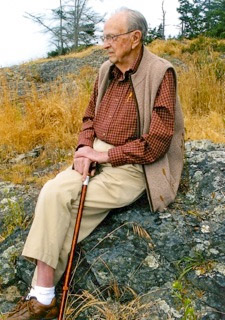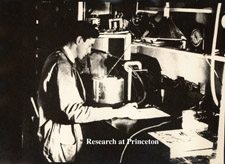Arthur H. Whiteley - 1916 - 2013
by Merrill Hille, Billie Swalla, Mineo Iwata, Patricia Morse, Lynn Riddiford, and Richard Cloney

Arthur H. Whiteley was a man who greatly appreciated art and science, and generously supported both endeavors at the Friday Harbor Laboratories and in the Department of Zoology at the University of Washington. He began his career doing physiology, but later was known as a sea urchin developmental and cell biologist. Arthur died April 15th, 2013, at his home in Seattle after a short illness. He was 96 years old and touched many lives in his lifetime.
Arthur will be remembered for his delineation of gene and protein expression in sea urchin embryos, his support of many students and colleagues, his nourishing of many developmental biology graduate students through the University-wide Developmental Biology Training Grant, his devotion to his wife Helen Riaboff Whiteley, and his founding of the Helen Riaboff Whiteley Center at Friday Harbor Laboratories. This is a special place for creative work, open to scientists, artists, and writers, that has generated many special projects after 13 years in operation. Arthur was born of English immigrants in the natural lake and river setting of southeastern Michigan. His father ran a daily newspaper and was a State Senator and Commissioner of Conservation. Conservation stuck with Arthur as he fought strongly for the restriction of salmon farming in Puget Sound from the 1980s to 2006 as President of the Marine Environmental Consortium-United States and Chairman of the San Juan Nature Institute (2006). Arthur received a B.A. in biology from neighboring Kalamazoo College and an M.S. in zoology from the University of Wisconsin. During these studies he worked in the field for the Michigan State Department of Conservation and studied limnology at the Douglas Lake Biological Station, perhaps inspired by a microscope he was given as a boy. In Madison he changed his interest from limnology to cell biology, for which he is famous not only for his studies, but for his teaching. He arrived in class with a huge stack of bound journals to show the students original studies from the literature. His erudition influenced not only his students but also subsequent instructors like Gerald C. Karp, the author of cell biology textbooks who as a graduate student published with Arthur on gastropod gene expression.

Arthur began his Ph.D. research at the University of California Berkeley with Sumner Cushing Brooks, pioneering studies on 32P in biology. There he met Helen Riaboff. In 1942 he moved to Princeton University to study the war-related subject of bends as it applied to aviators. He published 14 papers with E. Harvey Newton on bubble formation during skeletal muscle activity and its amelioration by pre- oxygenation. During this time he showed his joy in tinkering with and inventing laboratory equipment. After a year at the University of Texas Galveston, he found his life's studies on sea urchin embryos at California Institute of Technology with Albert Tyler, an eminent sea urchin biologist. In 1947 he began his career at the University of Washington where he joined several Berkeley colleagues, including Robert Fernald, who ran the Friday Harbor Labs for many years. At Friday Harbor, Arthur set up his own summer laboratory and developed with Robert Fernald and Richard Cloney the Comparative Invertebrate Embryology Course. His first paper on sea urchins with Edward L. (Ted) Chambers and Brooks in 1948, showed the activation of a protein carrier for rapid ATP-dependent uptake of phosphate at fertilization.
For a period Arthur's attention turned to metabolic enzymes with studies with Jean J. Comita, John W. Brookbank, J. B. Lichfield, Hironobu (Ed) Ozaki, and finally Eizo Nakano in Japan (1962). Arthur's work expanded to the DNA and RNA content of sea urchin embryos and his collaboration with Heinz and Karen Holter during a Guggenheim Foundation Fellowship in 1955. He established close friendships with Fritz Baltzer, Alberto Monroy, Max Møler, and Vance Tarter, his introduction to Stentor which he later studied with Ann James Frazier. His sabbatical in 1962 Japan sealed enduring friendships with Japanese colleagues including Katsuma Dan, Jean Dan, Eizo Nakano, and Motonori (Ghen) Hoshi to whom he brought the technique of protein gel electrophoresis. Exchanges between Seattle and Japanese scientists continued with his encouragement throughout his career, including a 1981 US-Japan Symposium he organized at the Friday Harbor Labs. In Seattle Arthur encouraged the studies of other invertebrates in his laboratory including tunicates (Charles Lambert) and Pacific oysters (K. W. McLean). With colleagues at the University of Washington, including Helen R. Whiteley and Brian McCarthy, Arthur continued through the rest of his academic career to study developmental and evolutionary changes in the gene program of echinoderm, especially with his former graduate student and collaborator Michael A. Harkey. He was known for giving his students an idea and letting them run with the projects. Such collaborations with his graduate students and postdocs were on uridine uptake (Joram Piatigorsky), histone expression (Douglas P. Eaton), the hatching enzyme (Richard M. Showman), activation of protein synthesis (Merrill B. Hille), and finally a focus on primary mesenchyme expression in sea urchins with Shigeki Mizuno, Yang Rim Lee, John Chamberlain, John Speith, Bruce Drager, Mineo Iwata, and Helen R. Whiteley.
Arthur and Bill Rutter of the Department of Biochemistry established the still existing University of Washington NIH Interdepartmental Developmental Biology Training Program in 1963. He directed the Program until 1985. He also founded the NW Regional Developmental Biology meetings sponsored by NSF and the Society for Developmental Biology held annually at Friday Harbor Laboratories. Arthur continued to celebrate his interests in scholarly achievements and exchanges. His last research paper was with Rosalie Langelan Duncan in 2011. He has had the first species of a new Nemertian genus named after him. Last summer he participated in the inauguration of six Japanese scholars to the E. S. Morse Institute for the exchange of scholars between the Friday Harbor Laboratories and marine laboratories in Japan. Arthur was made the first Honorary Scholar of this institute.
Above all Arthur will be remembered for his support of the international community of sea urchin developmental biologists and of the University of Washington Friday Harbor Laboratories, which he loved.
Arthur’s family has requested that any memorial contributions be made to the "Arthur H. Whiteley Memorial Fund" at FHL, which will benefit the Helen Riaboff Whiteley Center. If you would like to make a contribution online you can go directly to this secure site at the University of Washington. Or you may contact Rachel Anderson, rachelea@u.washington.edu, to make a donation.
FHL will host an event to honor Arthur Whiteley on September 7th. Please check the FHL website for details.
Arthur Whiteley's Oral History is Online
Arthur sat down with Dennis Willows for a few days in late May, 2011 to share his stories about his childhood, college days, the love of his life – Helen Riaboff Whiteley, his tenure at the University of Washington and Friday Harbor Laboratories. He also talked about the building of the Whiteley Center and his passion for conservation. Watch the video here..
Arthur came prepared by writing a timeline of his life. Rather than a list of pages and pages of academic achievements, Arthur focused on the people and the places that were dear to him. As Arthur tells his stories to Dennis, you will find a certain precision in details and yet, a genuine ho-hum-ness regarding his many personal accomplishments. Both his keen sense of humor and unabashed frankness are sprinkled throughout the stories he tells.
An obituary written by Merrill Hille, Billie Swalla, Mineo Iwata, Patricia Morse, Lynn Riddiford and Richard Cloney is posted on both the Friday Harbor Laboratories and University of Washington Biology Departure websites
As a starting point for his oral history, in 2011 Arthur created a timeline about his life, work, and partnership with his wife Helen. Click the following link to access the timeline: AH Whiteley Timeline.




